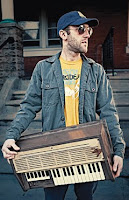How to Use the Machines for Good - RJD2's "Ghostwriter"
Posted 11/24/2009 by JDub in Labels: JDub, Machines, music, RJD2, Sampling A number of my previous posts have discussed the use of machines and computers to process naturally created music, especially vocals, for sonic effect. As pervasive as technology is these days in our society, it is becoming more and more normal for pop music on the radio to be heavily processed, to include digital samples of other music, or even to have been produced entirely on a computer (crank that Soulja Boy).
A number of my previous posts have discussed the use of machines and computers to process naturally created music, especially vocals, for sonic effect. As pervasive as technology is these days in our society, it is becoming more and more normal for pop music on the radio to be heavily processed, to include digital samples of other music, or even to have been produced entirely on a computer (crank that Soulja Boy).While it may not hit the radio waves any time soon, RJD2's "Ghostwriter" is an example of a song which was produced entirely of samples pieced together electronically.
Listen to RJD2's "Ghostwriter"
Many of the samples you hear in songs on the radio are only lightly modified or often lifted exactly from the original song, providing a sense of evocation and sometimes tribute. Jason Derülo's "Whatcha Say" prominently samples Imogen Heap's classic "Hide and Seek," evoking the song's history and lyrics while presenting it in a new paradigm.
Jason Derülo's "Whatcha Say" on YouTube
Using a sample evocatively, as in "Whatcha Say," often results in the sample needing to be manipulated to fit into the new song, perhaps by changing its tempo or pitch, or by processing it further still. Regardless, the moment a sample in a new song reminds you of the original song, the use of electronic manipulation is clearly recognizable.
The samples in RJD2's "Ghostwriter," however, operate in an entirely different manner. Rather than evoke a popular tune from yesteryear, RJD2 pieces together older and more obscure samples to create an entirely original piece of music. From Wikipedia, the recognizable samples in "Ghostwriter" are:
- "I Didn't Understand" Elliott Smith from his album XO.
- "Secretary" by Betty Wright
- The beginning of "Timesteps" by Wendy Carlos from the movie "A Clockwork Orange"
Aside from some sundry reversed samples and volume swells, the guitar, drums, bass, horns, and vocal parts sound for all the world like they were recorded in the studio as primary source. The samples no longer sound obviously like samples, but instead sound like normal, intentionally composed and recorded parts. Its as if a modern painter stripped paint from the canvasses of old works and applied them to a new canvas in totally new styles and compositions as though the paint were being used for the first time.
Because of this, I think of "Ghostwriter" as a piece of music which was composed, arranged, and produced by a unique artist without the overt reliance on digital editing and effects. The trained ear certainly recognizes it as a work of sampling, but the digital equipment is used as transparently as possible. In this way, the machine stands aside and allows direct connection between artist and listener the way any live recording of a band would.
Its record album scratchiness and the varying ages of its samples result in an aesthetic which has been described as "amateruish," somewhat rough, raw, and accessible. I think the song celebrates this aesthetic with a wry grin: creating such a "human" work of art digitally is very hard work indeed.
1 comment(s) to... “How to Use the Machines for Good - RJD2's "Ghostwriter"”






1 comments:
I'm pretty sure the guitar is from Harry Chapin's W.O.L.D.
http://www.youtube.com/watch?v=1l0fH0dRUow
Post a Comment